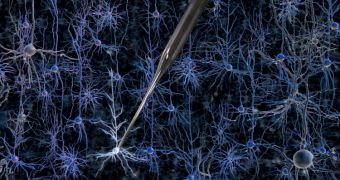A group of experts from the Massachusetts Institute of Technology (MIT) and the Georgia Institute of Technology (GeorgiaTech) announces the development of a robotic arm that can identify and record signals passed between neurons in the living brain.
In a series of experiments conducted on unsuspecting lab mice, the group demonstrated that the small machine, guided by a cell-detecting algorithm, can record these data faster and more accurately than human investigators can.
Scientists have been trying to demonstrate a way of analyzing electrical activity patterns in the brain for a very long time. Thus far, their efforts have only had limited success. Studying the living brain can also reveal other useful data, including the patterns in which genes are turned on or off.
This type of investigation is very complex. This is why only a small number of researchers and labs are carrying it out around the world. By developing the new robotic arm, it may be possible to have more scientists involved in this line of work.
In addition to eliminating the need for experts to conduct months-long training efforts, the new system is also automated, and capable of providing in-depth details about the activities living cells conduct.
The human brain contains thousands of cell types, and the robotic arm could be used to classify and catalog all of them with relative ease. The system could then map out the connections forming between these cells. Based on the data, it could figure out how healthy cells differ from diseased cells.
“Our team has been interdisciplinary from the beginning, and this has enabled us to bring the principles of precision machine design to bear upon the study of the living brain,” says Georgia Tech George W. Woodruff School of Mechanical Engineering assistant professor, Craig Forest, a co-leader of the study.
Former MIT visiting student Suhasa Kodandaramaiah, who is now Forest's graduate student, is the lead author of the research paper describing the findings, which appears in the May 6 issue of the top scientific journal Nature Methods.
Funding for the research came from the US National Institutes of Health (NIH), the National Science Foundation (NSF) and the MIT Media Lab. MIT associate professor of biological engineering and brain and cognitive science, Ed Boyden, was the other co-leader of the research effort.
“If you really want to know what a neuron is, you can look at the shape, and you can look at how it fires. Then, if you pull out the genetic information, you can really know what’s going on. Now you know everything. That’s the whole picture,” Forest concludes.

 14 DAY TRIAL //
14 DAY TRIAL //